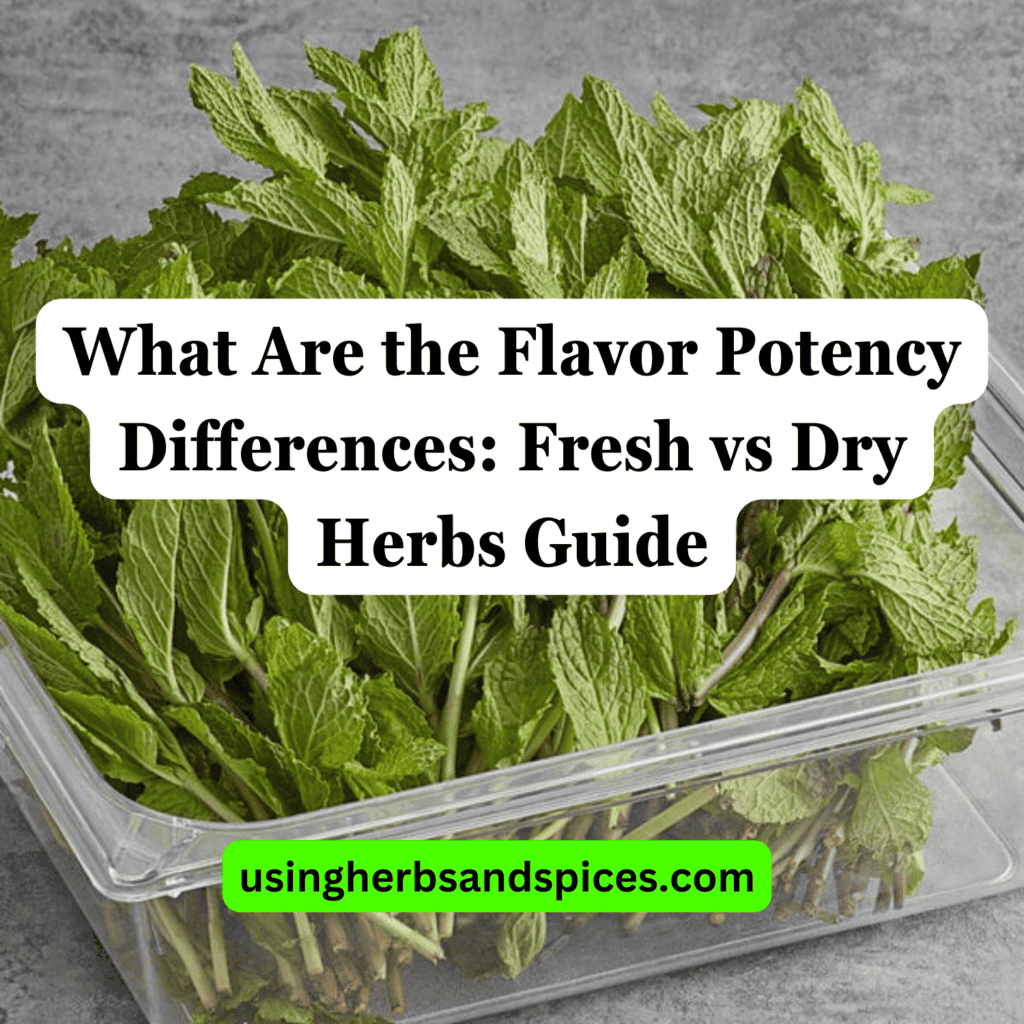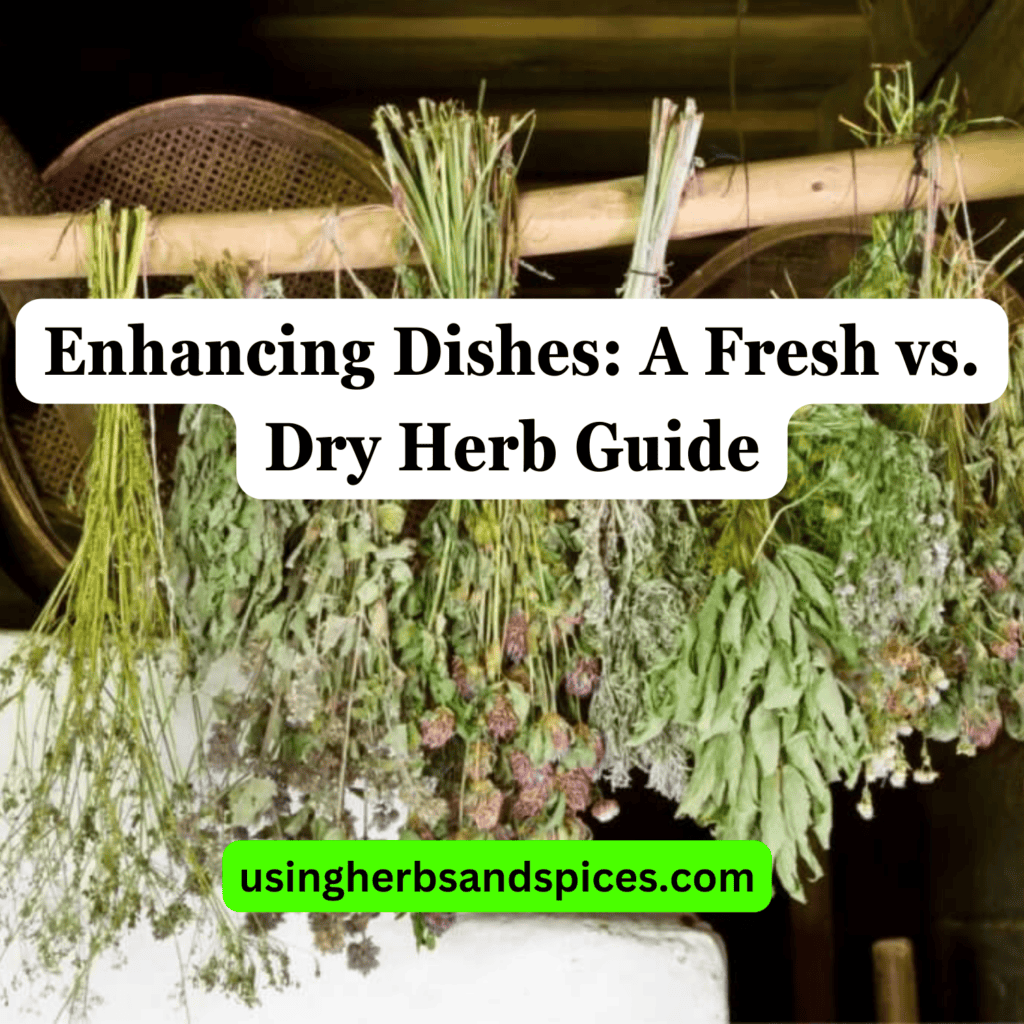SUMMARY: Dry herbs offer concentrated flavor and longer shelf life, ideal for cooked dishes, while fresh herbs provide vibrant taste and color, perfect for finishing touches. Choosing the right type for your dish can elevate its flavor profile significantly.
Ever find yourself puzzled over whether to use dry or fresh herbs to unlock the true potential of your dishes?

Understanding the significant impact each can have on flavor is crucial.
- Characteristics and benefits of dry herbs
- The vibrancy and application of fresh herbs
- How to choose between dry and fresh herbs for different culinary creations
- Techniques to maximize flavor using both types of herbs
Continue reading to discover how to make an informed decision that will elevate your cooking.
Understanding Dry Herbs: Concentration, Storage, and Use
Dry herbs, lauded for their concentrated flavors and longevity, are a staple in many kitchens worldwide. Their intense taste is attributed to the dehydration process, which removes moisture while preserving the essence of the herb. This makes them ideal for longer cooking processes where they have time to rehydrate and infuse the dish with their robust flavors.
When it comes to storage, dry herbs are relatively low maintenance. Kept in a cool, dark place, they can retain their potency for up to a year, sometimes longer. It’s important to note, however, that their flavors do diminish over time, so using them within their prime is key to achieving the best results.
Incorporating dry herbs is simple yet requires a bit of finesse. A general rule of thumb is to use one-third of the amount compared to fresh herbs, given their concentrated nature. Moreover, adding them early in the cooking process allows sufficient time for their flavors to meld beautifully with the other ingredients, creating a harmonious and richly flavored dish.
Embracing Fresh Herbs: Vibrancy, Preparation, and Application
The allure of fresh herbs lies not only in their vibrant color and texture but also in their ability to inject a burst of freshness into any dish. Unlike their dried counterparts, fresh herbs carry a lighter, more delicate flavor profile, making them ideal for incorporation into recipes at the last moment, preserving their brightness and aromatic qualities.
Fresh herbs are generally added towards the end of the cooking process, or used as garnishes, to maintain their flavor integrity. Their preparation is straightforward yet crucial; washing them just before use and chopping them finely maximizes their aromatic oils, thus enhancing their fragrance and taste in the dish. For those looking to preserve the essence of fresh herbs, techniques such as chopping and freezing in oil or blending into pestos offer ways to extend their life beyond the typical shelf life in the refrigerator.
Application of fresh herbs is versatile, from incorporating them into salads and dressings for a crisp, refreshing taste, to using them in cocktails and infused waters for a subtle flavor twist. The key to mastering the use of fresh herbs is understanding their flavor profiles and how they complement other ingredients, elevating simple dishes to extraordinary culinary experiences with just a sprinkle or a bunch.
Matching Herbs to Dishes: Dry vs Fresh Considerations
When it comes to infusing your dishes with flavor, the choice between dry and fresh herbs is pivotal. The selection should be guided by several factors: the cooking time, the intensity of flavor desired, and the texture that best complements the dish. Generally, dry herbs, being more concentrated, are suited for dishes requiring longer cooking times, such as stews and braises. Their potent flavor infuses the dish throughout the cooking process, developing depth and complexity.
On the other hand, fresh herbs often shine brightest in dishes that are cooked for shorter periods or not cooked at all. They offer a burst of freshness that can elevate a dish with a delicate vibrancy. Fresh herbs are particularly well-suited to salads, dressings, and as garnishes, where their texture and color can also play a significant role in the final presentation of the dish. However, when using fresh herbs in cooked applications, it’s usually best to add them towards the end of cooking. This approach maintains their color, texture, and flavor, ensuring they contribute a lively note to the finished dish.
Considering the type of cuisine can also guide your herb choices. Traditional recipes often specify the use of either dry or fresh herbs based on regional availability and historical culinary practices. Respecting these traditions can enhance the authenticity of the dish while exploring the balance between fresh and dry can lead to innovative flavors and textures. Ultimately, whether to use dry or fresh herbs comes down to personal preference and the specific demands of the dish, inviting both tradition and experimentation into the kitchen.
Maximizing Flavor: Techniques for Using Dry and Fresh Herbs
Unlocking the full flavor potential of herbs, whether dry or fresh, requires specific techniques to ensure their best qualities shine in your dishes. For dry herbs, one effective method is to ‘bloom’ them in a warm fat, such as oil or butter. This step, usually performed at the beginning of cooking, helps to release fat-soluble flavors, making the dish more aromatic and flavorful. Additionally, crushing dry herbs between your fingers before adding them to the dish can help to awaken their dormant flavors.
Fresh herbs, with their delicate flavors, often benefit from being added at the end of the cooking process or used raw. This preserves their vibrant color and fresh aromatic qualities. When incorporating fresh herbs into hot dishes, chop them finely to maximize their surface area, allowing their oils and aromas to infuse more effectively into the dish. For dishes like marinades, dressings, or sauces that are prepared cold, muddling the herbs gently before adding them can help release their flavors.
Moreover, understanding the pairings of herbs with the ingredients can amplify the taste of your dishes. For instance, robust herbs like rosemary and thyme marry well with hearty dishes, while softer herbs like basil and cilantro complement lighter fares. A balance of both dry and fresh herbs can be used to achieve a layered complexity of flavors that would be hard to attain using either alone. Experimenting with these techniques will lead to discovering the perfect herb-infused flavor balance for any dish.
Harnessing Dry and Fresh Herbs for Ultimate Flavor Mastery
In this exploration of herbs in culinary practice, we have uncovered the definitive impacts that both dry and fresh herbs have on flavor profiles. Here are the core insights:
- Dry herbs offer a concentrated flavor that is perfect for dishes requiring longer cooking times or a more pronounced taste.
- Fresh herbs bring vibrancy and a burst of flavor that can elevate a dish with their aromatic qualities, ideal for finishing touches and fresh applications.
- Choosing between dry and fresh herbs depends on the specific needs of the dish, including cooking technique and the desired intensity of flavor.
- Understanding the proper use and application of herbs can significantly enhance the flavor and overall outcome of your culinary creations.
- Both dry and fresh herbs are valuable in their own right, offering versatile options for flavoring dishes across all types of cuisine.
Embracing the unique qualities of both dry and fresh herbs in cooking not only maximizes flavor but also broadens the culinary repertoire, allowing for more dynamic and exciting dishes.
Dry Herbs Vs Fresh in Cooking FAQs
How long do dry herbs last compared to fresh?
Dry herbs, when stored properly in a cool, dark place, can last up to one to three years while retaining most of their flavor. In contrast, fresh herbs have a much shorter shelf life, typically lasting up to a week or two in the refrigerator. The key to maximizing the longevity and flavor of both is proper storage, with dry herbs needing an airtight container away from light and heat, and fresh herbs often benefiting from being stored in a glass of water or wrapped in a damp paper towel.
Can fresh herbs be substituted for dry ones in recipes? How?
Yes, fresh herbs can be substituted for dry ones in recipes and vice versa. A general rule of thumb is to use a ratio of 3:1, meaning if a recipe calls for 1 teaspoon of dry herbs, you can substitute it with 3 teaspoons (or 1 tablespoon) of fresh herbs. This is due to the stronger, more concentrated flavor of dry herbs compared to their fresh counterparts. However, adjustments may need to be made based on personal taste and the strength of specific herbs.
What are the best practices for storing fresh herbs to maintain their flavor?
To maintain the flavor and longevity of fresh herbs, they should be stored properly in the refrigerator or at room temperature, depending on the type of herb. Soft-stemmed herbs like cilantro, parsley, and basil can be stored upright in a glass of water, much like cut flowers, and covered loosely with a plastic bag. Hard-stemmed herbs, on the other hand, should be wrapped in a damp paper towel and placed in a plastic bag in the refrigerator. These methods help maintain moisture and freshness, effectively prolonging the usable life of the herbs.









